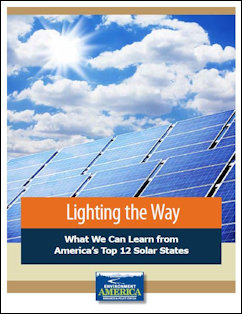Solar energy is economically competitive in many parts of the United States today, and it soon could become competitive in Virginia. The power source has a higher hurdle to overcome here than in many states — electric rates that are 13% lower than the national average, according to U.S. Energy Information Administration data. But relentless progress in the science of converting sunlight into energy suggests that solar will steadily erode the competitive advantage of other fuels, even in Virginia.
Over and above the fact that solar’s fuel source — the sun — is free, solar enjoys other economic advantages. Because residential and commercially generated solar electricity can be consumed in place, there is no need to invest in long-distance transmission lines, nor is there “line loss,” the leaking of electricity from electric lines. Solar panels also provide “peaking power” — they generate the most electricity in the afternoon when temperatures and electricity demand are the highest. And then there are the environmental advantages — solar power doesn’t pollute or emit CO2, the greenhouse gas implicated in global warming.
Solar power is so all-around awesome that Environment America Research & Policy Center has published a paper, “Lighting the Way: What we Can Learn from America’s Top 12 Solar States,” which makes the case that solar energy is good for consumers, the environment and the economy. The paper points to the 12 leading solar states for others to emulate. Arizona, the national leader, has installed solar capacity of 167 watts per capita. By comparison Virginia ranks 30th, with a mere 12 watts per capita.
Of course, Arizona is further south and has far fewer cloudy days, so one would expect solar to perform well there. But a less-than-ideal geographic location shouldn’t stop a state from installing solar, the paper says. North Carolina, which has lower overall electric rates than Virginia, averages 23 watts per capita, while Maryland averages 19.
“We have plenty of sunshine here in the state,” Lilias Gordon, campaign organizer with Environment Virginia, told the Richmond Times-Dispatch. “We just have to make sure we are capitalizing on it with good clean-energy policy.”
According to the report, here is what states and localities can do to encourage the use of more solar:
- Local governments should adopt policies guaranteeing homeowners and businesses the right to use or sell power from the sunlight that strikes their property (establishing net metering and overruling covenants in homeowner associations), enact solar-friendly zoning, and adopt bulk purchasing programs for solar installations.
- State governments should use their regulatory powers to implement rate structures that maximize the benefits of solar energy to consumers and support a smart electric grid in which distributed sources of energy such as solar play a larger role.
- All levels of government should install more solar energy in government buildings.
The biggest obstacle to large-scale adoption of solar is intermittent nature of the power source. Electric output of solar panels very directly with the strength of the sun. Clouds reduce solar generation, which compels an electric utility either to find power from another source or to curtail consumption. The study acknowledges the problem.
In states where large amounts of solar or wind power are going online, one emerging challenge for regulators is ensuring that [the] grid remains stable when the sun isn’t shining or the wind isn’t blowing. In California, for example, where solar energy is growing quickly, the state’s major grid operator has warned that, by 2020, daily patterns of electricity consumption could change to result in the need for a rapid ramp-up in power generation each evening after the sun sets. … In order to keep the amount of power on the grid stable with increasing penetrations of solar energy, grid operators need efficient and flexible power resources that can mirror the variability of solar output.
California has taken steps to accelerate the adoption of battery storage technology. The idea is to capture excess solar production during the day, store it in batteries, and draw it down at night. Analysts are optimistic that battery storage costs will decline dramatically over the next five years. Who pays for that storage, and how much it will add to the cost of electric power use, is still hazy. Also, a reliance on solar/battery-driven electric system could collide with another environmental desiderata — the use of electric vehicles, which would recharge primarily at night.
Bacon’s bottom line: Solar is coming sooner or later, and Virginia needs to have a serious discussion on how to integrate it into the grid. “Lighting the Way” illuminates the wide array of policy options available to the state. But other than pointing to battery technology that may or may not materialize, it doesn’t seriously address the issue of grid stability.
From my semi-informed perspective (I know enough to be dangerous), we have to ask a fundamental question. Do we want to stick with our current model, which relies heavily upon large, centralized plants, including industrial-sized solar facilities, that shuttle excess power across a multi-state region over a centralized transmission grid? Or do we shift to a more flexible, distributed “smart” grid that incorporates a wider diversity of small-scale power sources. Put another way, do we go with a centralized, economies-of-scale model or a distributed, small-is-beautiful model?
We’re not having that conversation, and we need to.



